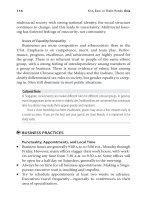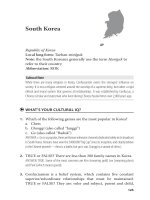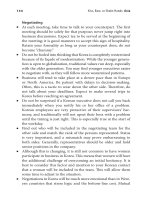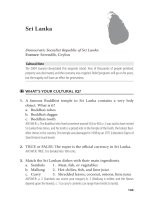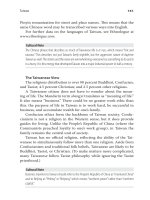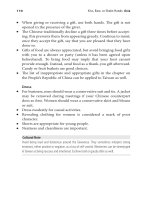How to Do Business in 12 Asian Countries 19
Bạn đang xem bản rút gọn của tài liệu. Xem và tải ngay bản đầy đủ của tài liệu tại đây (156.61 KB, 9 trang )
143
Sri Lanka
Democratic Socialist Republic of Sri Lanka
Former: Serendib, Ceylon
Cultural Note
The 2004 tsunami devastated this exquisite island. Tens of thousands of people perished,
property was decimated, and the economy was crippled. Relief programs will go on for years,
but the tragedy will have an effect for generations.
●
3
WHAT’S YOUR CULTURAL IQ?
1.
A famous Buddhist temple in Sri Lanka contains a very holy
object. What is it?
a. Buddha’s robes
b. Buddha’s dagger
c. Buddha’s tooth
ANSWER: c. The Buddha (who lived sometime around 563 to 483
b
.
c
.) was said to have visited
Sri Lanka three times, and his tooth is a prized relic in the Temple of the Tooth, the holiest Bud-
dhist shrine in the country. This temple was damaged in 1998 by an LTTE (Liberation Tigers of
Tamil Eelam) truck bomb.
2.
TRUE or FALSE: e rupee is the ocial currency in Sri Lanka.
ANSWER: TRUE. It is divided into 100 cents.
3.
Match the Sri Lankan dishes with their main ingredients.
a. Sambols 1. Meat, sh, or vegetables
b. Mallung 2. Hot chilies, sh, and lime juice
c. Curry 3. Shredded leaves, coconut, onions, lime juice
ANSWER:
a. 2 (Sambols can scorch your tongue); b. 3 (Mallung is milder, and the flavors
depend upon the leaves); c. 1 (a curry’s contents can range from lentils to lamb).
144
Kiss, Bow, or Shake Hands: Asia
●
3
TIPS ON DOING BUSINESS IN SRI LANKA
●
e largest ethnic population in Sri Lanka are the Sinhalese, who
are usually Buddhists. Tamils, who make up about 20 percent of
the population, are generally Hindus (or Muslims). Consider their
belief systems when you conduct business, or entertain them. For
instance, Buddhists are generally vegetarians, Hindus do not eat
beef, and Muslims do not eat pork.
●
Meals are important events, and should be shared with your Sri
Lankan counterparts as oen as possible.
●
Try local cuisines, and denitely learn about their tea. Tea
plantations are placed at high altitudes for the cool air, and the
handpicked teas grown at the highest elevation are regarded as
premium.
●
Time is exible in Sri Lanka. Westerners will be expected to con-
sider time money, but your Sri Lankan counterparts will not share
your attitude.
●
e tsunami has touched innumerable lives in Sri Lanka, from
the way they view daily life, to work, to how they eat. For exam-
ple, even though many Sri Lankans would normally eat sh,
the catches remained untouched in many markets during 2005,
because the shoppers were afraid that the sh have been feeding
on the carcasses of the thousands of relatives who were swept
away to sea.
●
Highly aggressive negotiating tactics are not commonplace. e
relationship and trust that your business partner has with you is
more important than the concrete margins of your deal. All par-
ties should benet from every agreement in the business matters
that you are involved in.
Cultural Note
During the British colonial occupation (in the 1800s), coffee was Sri Lanka’s main crop.
However, most of the coffee crop was decimated by a leaf blight in the 1870s, so the mainstay
coffee plantations were replaced by tea and rubber. Sri Lanka and India are now the two
largest exporters of tea in the world.
●
3
COUNTRY BACKGROUND
Demographics
Of Sri Lanka’s 20 million inhabitants (2006 estimate), 74 percent
are Sinhalese, 18 percent are Tamil, 7 percent are Moor, and 1 percent
are Burgher (descendants of Dutch colonists), Malay, and Vedda. e
Veddas are a small remnant of the island’s original inhabitants who
have assimilated into Sri Lankan society and lost all traces of their
original culture and history. Ethnic divisions between the Sinhalese
and the Tamils run deep, and violent strife has been a problem since
1983. Tamils are generally concentrated in the “tea country,” the
northern part of the island.
History
e rst Sinhalese immigrants to Sri Lanka arrived in the sixth cen-
tury from northern India. ree hundred years later, Buddhism was
brought with the Indian prince Mahinda, son of the great Buddhist
king Asoka. e religion ourished and became central to the culture.
e Portuguese were the rst Europeans to arrive in Sri Lanka
in the sixteenth century; they brought Catholicism with them. e
Dutch followed in the next century, and nally the British arrived and
declared it the British colony of Ceylon in 1815. During this colonial
period, tea, rubber, and coconut plantations were established in the
northern part of the island, and labor was brought over from the
Tamil Nadu province in India. Sri Lanka’s independence was peace-
fully obtained on February 4, 1948.
Since that time, free elections have been the vehicle for transfer
of power, with the exception of the assassination of Prime Minister
Bandaranaike in 1959. In 1971, an uprising of a Maoist group caused
the government, under Bandaranaike’s widow, to declare a state of
emergency and suppress the insurrection. Although the revolt was
put down in a few weeks, the state of emergency lasted six years. Par-
tially in response to the turbulence, a new constitution was written
that changed the country to a republic and its name to Sri Lanka. In
addition, it created a presidency (appointed by the prime minister)
and initiated economic policies that were highly socialistic.
Sri Lanka
145
146
Kiss, Bow, or Shake Hands: Asia
In 1977, a change in political parties brought a new constitution
and an open economy under J. R. Jayewardene. At that point, the
Tamils’ demand for more equalization at the federal level changed to a
demand for an independent state of Tamil Eelam. e extremist LTTE
resorted to force to achieve their goals. In 1983, the deaths of thirteen
Sinhalese soldiers caused violent confrontations. Bloodshed, terrorism,
and accusations of human rights violations occurred on both sides.
In 1987, the situation was deadlocked. India became involved by
sending peacekeeping troops to help resolve the crisis. An accord
was signed that made concessions to some of the militants’ demands,
including giving ocial status to the Tamil language. But the militant
troops backed out on their agreement to surrender to the Indian
peacekeeping force. e ghting continued, and Indian troops
remained in northern Sri Lanka for two years.
Aer the negotiated Indian withdrawal occurred in 1990, elec-
tions were held in the newly restructured provinces. With the result-
ing victory in Tamil strongholds and the seats won in the National
Assembly, the militants halted activities. However, ghting broke
out again in June 1990. Several hundred people were killed before a
cease-re was declared.
Since then, the LTTE terrorist activities have continued their
political violence, including assassinations of politicians, bombings,
and attacks on religious sites. In spite of these hostilities, the country
is relatively stable politically.
e government has sold over y state-owned companies in
recent years, and Colombo has a modern stock exchange. If inter-
national aid continues, and the plans for growth in the telecom and
nancial services areas can be implemented, Sri Lanka will regain its
economic position in the next few years.
Type of Government
e Democratic Socialist Republic of Sri Lanka is a unitary mul-
tiparty republic. Under the constitution of 1978, there is a strong
executive president, elected for a six-year term, and a prime minister.
ere is a unicameral National Assembly. e president is head of
both the state and the government.
Internationally, Sri Lanka maintains a nonaligned foreign policy.
Relations with India, which have been tense in the past, remain a
focus of attention.
Current government data can be found at the Embassy of Sri
Lanka at www.slembassyusa.org or the ocial Web site of the govern-
ment of Sri Lanka at www.priu.gov.lk.
Language
Sri Lanka has two ocial languages, spoken by the two dominant
ethnic groups. e Sinhalese speak Sinhala, and the Tamils speak
Tamil. English, a legacy from the colonial period, is the language of
commerce and is spoken in tourist areas, and most businesspeople
and senior civil servants speak it uently. For data on the various
languages of Sri Lanka, see Ethnologue at www.ethnologue.com.
Cultural Note
Although its influence is declining, a caste system (called jati, or “birth,” in Asia) still exists
in Sri Lanka. This system dictates a person’s social standing, occupation, and even marriage
possibilities. While there are only four traditional castes, these are broken down into thousands
of subcastes. The concept of purity is integral to the caste system. Not just physical purity, but
spiritual—which leads to personal enlightenment as the ultimate goal. The preservation of
psychic purity was historically a main reason for segregating interaction between castes.
The Sri Lankan View
When Buddhism went into decline in India, Sri Lanka emerged as
a Buddhist stronghold in southern Asia. e majority of the popula-
tion claim Buddhism as their religion. Of the remaining citizenry,
approximately 20 percent are Hindu, with the remaining being
Christians and Muslims.
Buddhism is a strongly held belief system, which can be inter-
preted in various ways. Briey, Buddhists follow the teachings of
Buddha; they believe in the dharma (the truth, the law or the teach-
ing); and they belong to the sangha (the community). Buddhism has
many precepts that are explained beautifully in hundreds of books,
and dozens of Web sites.
Sri Lanka
147



